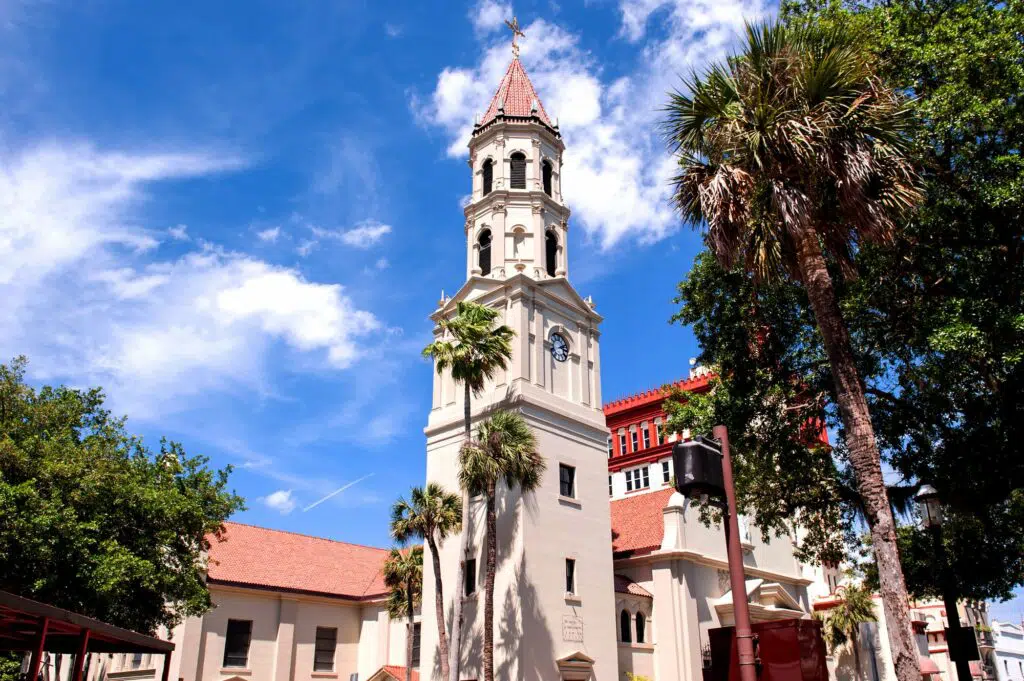The Cathedral Basilica of St. Augustine is the seat of the current Bishop of the Diocese of St. Augustine and is the oldest Catholic Church in the country. This is where the city of St. Augustine was founded in September 1565, more than a century before many other American towns were ever established. Known as the “Ancient City”, St. Augustine played a central role in the history of Florida, with the building of what is now known as the Cathedral Basilica of St. Augustine beginning within hours of the city being formally founded.
Inside the Cathedral Basilica of St. Augustine, the walls are decorated with beautiful murals, which showcase scenes, which highlight the importance of the Catholic Church in the development of the New World. The life of Saint Augustine of Hippo, after who the city of St. Augustine was named, is also depicted in a series of stained glass windows inside the cathedral. St. Augustine’s Spanish roots have inspired the stunning decor and architecture of the Cathedral Basilica of St. Augustine, which help it to stand out as one of the most charming cathedrals or churches in the region.
Continue reading to learn more about the history of the Cathedral Basilica of St. Augustine and its significance in the history of Florida.
Back To The Beginning
In 1565, Spanish explorer Don Pedro Ménendez de Avilés officially founded the city of St. Augustine after sailing from Cádiz in Spain. On the feast day of Saint Augustine of Hippo, Pedro Ménendez first laid eyes on the east coast of Florida and he named the new settlement San Agustín in honor of the revered saint. On September 8th, 1565, Menendez and his men reached land and celebrated mass in recognition of their accomplishments. This began the establishment of what we know nowadays as the Cathedral Basilica of St. Augustine.
Building Of The First Church
Most of Pedro Menéndez’s crew were sailors, with no real architectural or building skills to speak of. Despite their lack of building experience, they worked together and used locally found materials to build a simple but certainly not very solid church on the site where they first said mass.
Francis Drake’s “Great Expedition”
Just twenty years later, in 1585 English explorer, sea captain, privateer, and naval officer, Sir Francis Drake, sailed to the New World after war broke out between England and Spain. On a mission to attack the Spanish New World, he and his crew first attacked Santiago in the Cape Verde Islands off the northwest coast of Africa before crossing the Atlantic. On February 19th, 1586, they carried out a successful attack on the important city of Cartagena northern coast of Colombia in the Caribbean Coast Region.
Raid On St. Augustine
Following their success thus far, Sir Francis Drake decided to attack one more Spanish Colony city before traveling north to Roanoke, where Sir Walter Raleigh had set up a new British colony. With their course set for the Florida peninsula, Drake and his men spotted a small inlet with a fort nearby, which would turn to be St, Augustine, the most northerly settlement in the Spanish New World. Knowing that this was also the site where Pedro Menéndez had ordered the massacre of 235 French Huguenots, he decided to seek revenge for his fellow protestants.
Sir Francis Drake and his crew captured the city of St. Augustine, in what has been dubbed “The Raid On St. Augustine”. Upon capturing the city, the English expedition fleet pillaged and burned everything they could find in St. Augustine, including the church built by Pedro Menéndez and his men.
The Spanish Retreat
Realizing they were vastly outnumbered by the English fleet, the Spanish retreated inland, along with their native Indian allies, the Timucua. Planning to attack the English during the night, the Spanish failed to compete with Drake’s men. After the attack, Drake and his crew moved north to Roanoke in search of Raleigh’s settlement, cruising into modern-day Charleston Harbor before eventually making contact with the British settlers on Roanoke Island.
After the English left, Menéndez and his men returned to find very little of their settlement other than smoldering ruins. To begin the rebuilding, they reached out to the viceroy of Cuba for assistance who agreed to help so that they could start to rebuild St. Augustine. They built a new church using palmetto and straw, which unfortunately did little to hold up to Florida’s humid climate.
A City Without A Church
A fire broke out soon after which destroyed the church once again leading to a third church being built. This time, timber was used in the construction as it was deemed to be a stronger material. However, because of the climate, a growing congregation, and poor upkeep of the church, it deteriorated over time and in 1702, it was once again destroyed in an invasion by James Moore, colonial of South Carolina. Despite numerous attempts to rebuild the St. Augustine church, the city went without a place of worship for more than ninety years.
Building The Cathedral Basilica Of St. Augustine We Know Today
Over the next fifty to sixty years, Catholicism started to decline in Florida until, in 1767, workers from Greece, Italy, and Minorca arrived, bringing with them their Catholic faith. In 1784, the English handed Florida back to Spain, reinvigorating Spanish Catholicism in the region. With a new sense of pride, the Spanish royal family ordered the construction of a new church, and the cornerstone of what we now know as the Cathedral Basilica of St. Augustine was laid in 1793.
